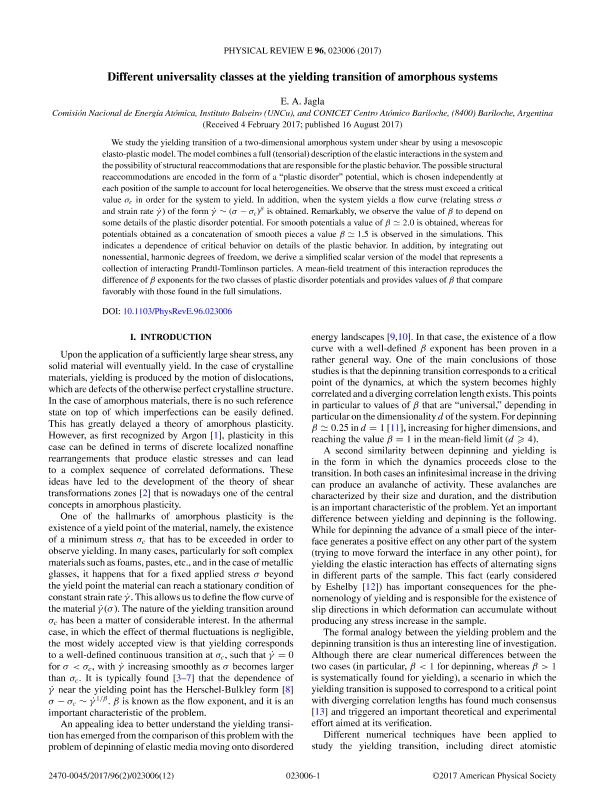Mostrar el registro sencillo del ítem
dc.contributor.author
Jagla, Eduardo Alberto

dc.date.available
2019-03-19T15:56:46Z
dc.date.issued
2017-08
dc.identifier.citation
Jagla, Eduardo Alberto; Different universality classes at the yielding transition of amorphous systems; American Physical Society; Physical Review E; 96; 2; 8-2017
dc.identifier.issn
2470-0053
dc.identifier.uri
http://hdl.handle.net/11336/71999
dc.description.abstract
We study the yielding transition of a two-dimensional amorphous system under shear by using a mesoscopic elasto-plastic model. The model combines a full (tensorial) description of the elastic interactions in the system and the possibility of structural reaccommodations that are responsible for the plastic behavior. The possible structural reaccommodations are encoded in the form of a "plastic disorder" potential, which is chosen independently at each position of the sample to account for local heterogeneities. We observe that the stress must exceed a critical value σc in order for the system to yield. In addition, when the system yields a flow curve (relating stress σ and strain rate γ) of the form γ ∼(σ-σc)β is obtained. Remarkably, we observe the value of β to depend on some details of the plastic disorder potential. For smooth potentials a value of β≃2.0 is obtained, whereas for potentials obtained as a concatenation of smooth pieces a value β≃1.5 is observed in the simulations. This indicates a dependence of critical behavior on details of the plastic behavior. In addition, by integrating out nonessential, harmonic degrees of freedom, we derive a simplified scalar version of the model that represents a collection of interacting Prandtl-Tomlinson particles. A mean-field treatment of this interaction reproduces the difference of β exponents for the two classes of plastic disorder potentials and provides values of β that compare favorably with those found in the full simulations.
dc.format
application/pdf
dc.language.iso
eng
dc.publisher
American Physical Society
dc.rights
info:eu-repo/semantics/openAccess
dc.rights.uri
https://creativecommons.org/licenses/by-nc-sa/2.5/ar/
dc.subject
Plastic Yielding
dc.subject.classification
Astronomía

dc.subject.classification
Ciencias Físicas

dc.subject.classification
CIENCIAS NATURALES Y EXACTAS

dc.title
Different universality classes at the yielding transition of amorphous systems
dc.type
info:eu-repo/semantics/article
dc.type
info:ar-repo/semantics/artículo
dc.type
info:eu-repo/semantics/publishedVersion
dc.date.updated
2019-03-08T16:34:11Z
dc.journal.volume
96
dc.journal.number
2
dc.journal.pais
Estados Unidos

dc.journal.ciudad
Ridge
dc.description.fil
Fil: Jagla, Eduardo Alberto. Consejo Nacional de Investigaciones Científicas y Técnicas; Argentina. Comisión Nacional de Energía Atómica. Gerencia del Área de Energía Nuclear. Instituto Balseiro; Argentina. Comisión Nacional de Energía Atómica. Centro Atómico Bariloche; Argentina
dc.journal.title
Physical Review E
dc.relation.alternativeid
info:eu-repo/semantics/altIdentifier/doi/https://dx.doi.org/10.1103/PhysRevE.96.023006
dc.relation.alternativeid
info:eu-repo/semantics/altIdentifier/url/https://journals.aps.org/pre/abstract/10.1103/PhysRevE.96.023006
Archivos asociados
